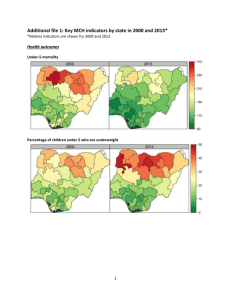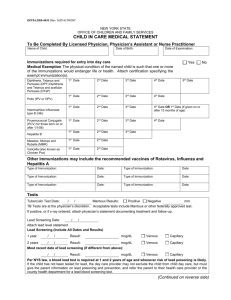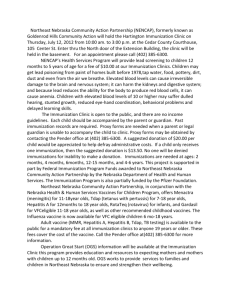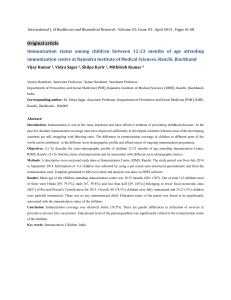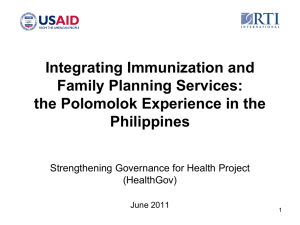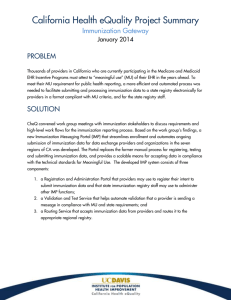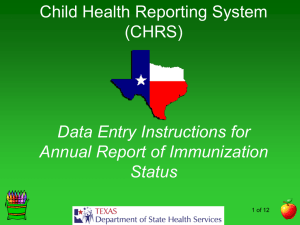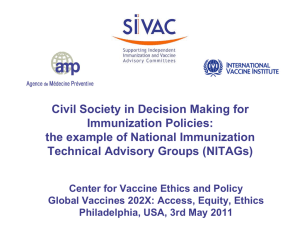Ms_Mridula_Bajaj
advertisement
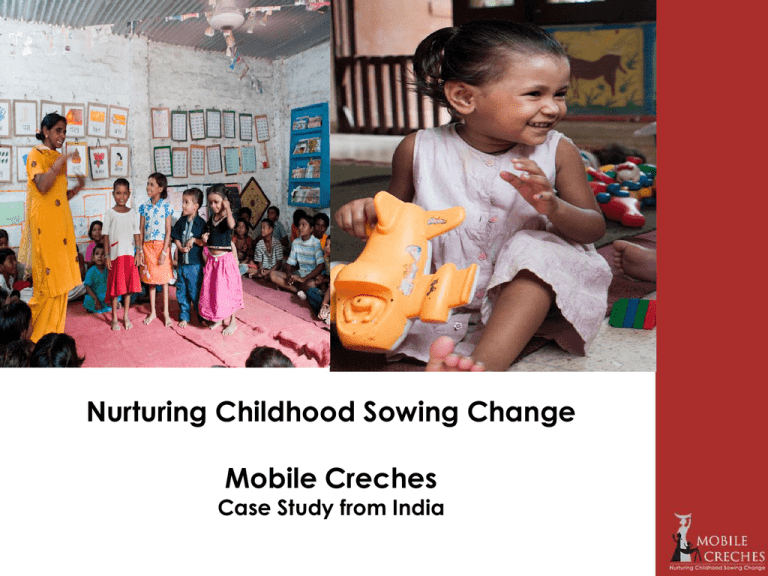
Nurturing Childhood Sowing Change Mobile Creches Case Study from India Presentation Outline • Situation of the Young Child • The migrant child – going nowhere - Impact of Migration on Children • Mobile Creches’ Response - Daycare centre at construction sites - Delivery model - Programme, Impact, cost - Features responsible for ensuring and sustaining quality • Growing up in Delhi’s Slums • Mobile Creches response for children in urban settlements - Strategies adopted for settled populations - Impact and achievements - Features responsible for success Situation of the Young Child • 160 million children under 6yrs - 60 million living in poverty • 47% children are malnourished • 61% children not fully immunized • 80% children born with low birth weight • 38% children 3-6yrs attend pre-school • 76% children complete primary school The Unmet Need: ECCD 60 million children in need of ECCD services •The ‘What’: maternal health, new born health; maternity support; breastfeeding; immunization; early stimulation; growth monitoring; appropriate and adequate nutrition; pre-school •The ‘Why’: Citizenship; Science; Equity; Economic rationale Mobile Creches Response MC Strategic Thrust affected by migration For Young Child in settled urban communities I. Service Delivery - Daycare Centres at Construction Sites - service delivery models; facilitation models II. Community Facilitation - Ensuring childcare at Urban Settlements - awareness and demand creation models ↓ ↓ ↓ Learnings feed into •Networking with NGOs and other campaigns to strengthen movement - demand for quality services for young child •Training in Childcare – build capacities for early childcare and good practices for other NGOs •Advocacy with the Government – improved policies and programmes for migrant and young children The Migrant Child - going nowhere Impact of migration on the child • Average duration of stay on a site - 4 months • 70% malnutrition • Incomplete immunization • No response or outreach from state services • Young child (under 3 yrs) - breast feeding impossible, delayed weaning, denied immunization – increased malnutrition, morbidity and even mortality • Preschool child (3-6 yrs) - supplementary nutrition and health compromised, lack of care and learning opportunities • Older child (6 yrs and above) - interrupts schooling, dropouts, child labour, no peer support, likely early marriage I. MC Daycare Centres at Construction Sites Integrated Program • Age Appropriate needs of children • Play way, childcentred approach • Readiness skills • Mainstreaming • Tutorial support • 3 times hot cooked wholesome balanced nutritious meal • Growth monitoring • Special diet for the malnourished • One-to-one interaction, Mothers’ meeting, Street plays, media, etc. • Building local leadership Nutrition Education Community Communication Health • Regular health checkups • Immunization • Vitamin A, Iron supplementati on • Deworming Impact of Day Care Program (through 18-20 centres) • Safety, security and protection for 1200 children • Sibling Care Relief - 400 children • Nutritional Grade Improvement – 67% • Age Appropriate Immunization – 94% • Learning Levels: improved performance on gross motor development, confidence levels, cognition (91%) • Mainstreaming older children – 20-30% • Linkage with Government Health Services – 90% Outcomes Nutritional Status: improved due to supplementary nutrition program – 500cal/20gm protein/day (Children at centre for six months or more – 73% showed improvement) 10% Grades improved 17% 49% Grades retained Grades unchanged 24% Grades deteriorated Learning Capacities Impact of Educational interventions (Balwadi Evaluation Study): Children at MC (More than 200 days): • Improved performance on parameters of language (87%), cognition(91%), creativity and physical development (77%). • Total Score: 85% in comparison to 67% for those spending 50100 days Organization Features Three Critical Pillars 1. Programme Design – Professional inputs, periodic evaluations and reviews, procedures, guidelines 2. Supporting Systems (MIS, Procedures, guidelines and Admin support) 3. HR Systems Fundamental Principles guiding Programme Design for all components • Focus on all the age groups – conception - 12yrs • Holistic approach – focusing on all domains of development • Minimal facilities and low cost materials • Accessibility – timings, location • Flexibility – Responds to specific needs • Inclusive – children with different abilities • The Rights approach • Stake holders Participation– children, parents, contractors • Respect for community culture, tradition and ethos • Community awareness and participation- sustaining impact - building community leadership (Saathi Samooh) - parent’s meetings, street plays, media, campaigns, community events • Accessing government facilities – mainstreaming, immunization Supporting Systems 1. Operational guidelines documented 2. Control systems for follow up and supervision 3. Structured Supervision & Monitoring systems 4. Reporting structure including MIS for feedback to MC senior management 5. Oversight by Governing Board HR Systems • Organizational structure • Clarity on roles and job responsibilities • Building and strengthening human resource systems - a positive work culture fostering shared learning • promoting staff motivation through continued professional growth and joint problem-solving • Regular performance management system with recognition, acknowledgement, promotional and incentive systems How much does it cost to provide quality ECCD • Approx. Rs.1000/- per month / child • Operational costs 80% • Supervisory, support, building 20% monitoring, capacity Growing Up in Delhi’s Slums • Total under 6 population 19.23 lac (census 2001) • 12 lac under 6 children (64%) live in Urban Poor Settlements (DES 2007-2008) Children Health Status 75%children under 3 suffer from diarrheoa and 63% have anaemia MC’s Response for settled populations Facilitation • Awareness on importance of 0-6 yrs and implication of neglect • Building community groups • Family based interventions for change in child care practices • Demonstration model of Community based child care services with training and capacity building support • Linkages with government services and schemes – health Impact of Urban Interventions • Reaching approximately 4800 children under 6 • 72% - Improvement in nutrition grade • 80% - Birth registration • 92% - Immunization •Linkage to ICDS 1400 children MC’s Achievements • Reached out to 7,50,000 children • Multiple models in partnership with communities and Builders/contractors • 8 community groups - 4 are registered with young issues in their bye- laws child • 80 anganwadis opened through demand generation from community • Trained 6,500 Childcare workers • National Advocacy – Lobbied for and provided inputs for better Laws , Policies, Programmes and Schemes Let us work together to give back a happy childhood to all children… www.mobilecreches.org
